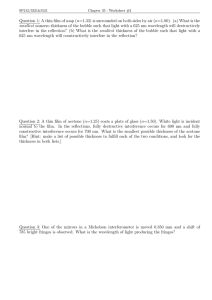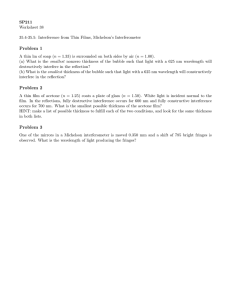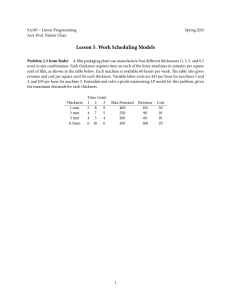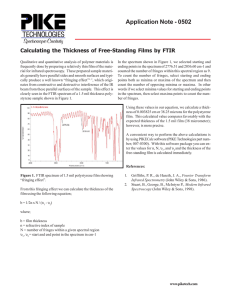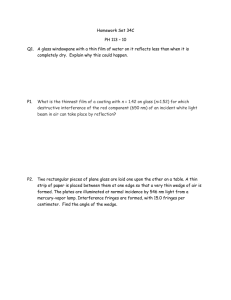Newton`s Rings - The Society of Vacuum Coaters
advertisement
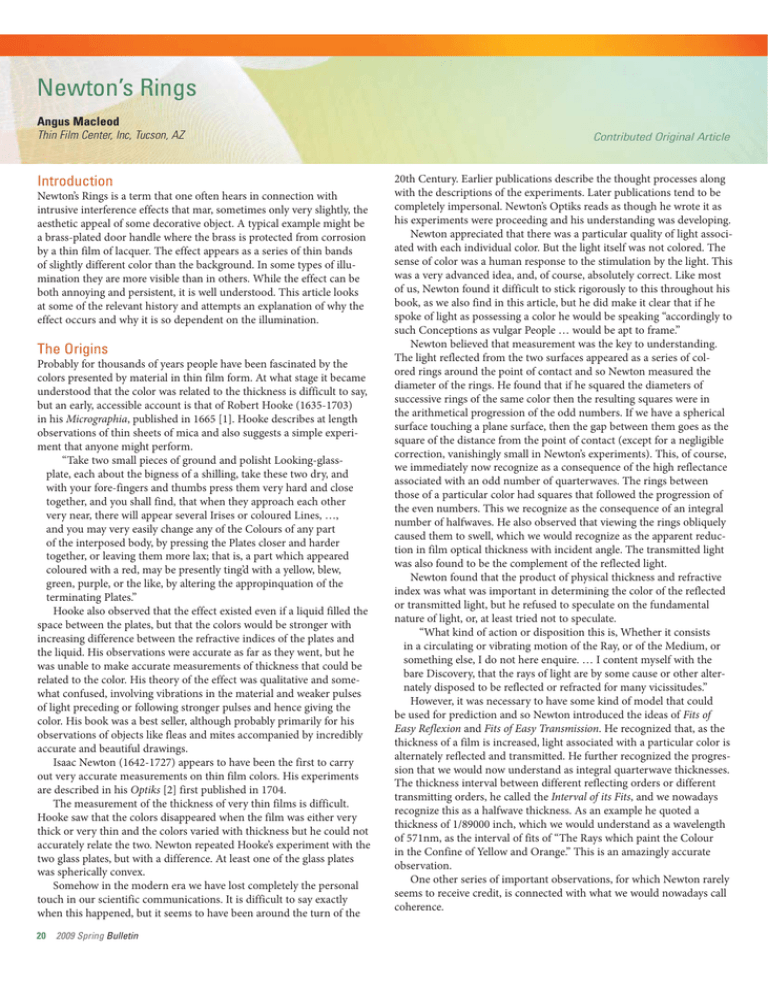
Newton’s Rings Angus Macleod Thin Film Center, Inc, Tucson, AZ Introduction Newton’s Rings is a term that one often hears in connection with intrusive interference effects that mar, sometimes only very slightly, the aesthetic appeal of some decorative object. A typical example might be a brass-plated door handle where the brass is protected from corrosion by a thin film of lacquer. The effect appears as a series of thin bands of slightly different color than the background. In some types of illumination they are more visible than in others. While the effect can be both annoying and persistent, it is well understood. This article looks at some of the relevant history and attempts an explanation of why the effect occurs and why it is so dependent on the illumination. The Origins Probably for thousands of years people have been fascinated by the colors presented by material in thin film form. At what stage it became understood that the color was related to the thickness is difficult to say, but an early, accessible account is that of Robert Hooke (1635-1703) in his Micrographia, published in 1665 [1]. Hooke describes at length observations of thin sheets of mica and also suggests a simple experiment that anyone might perform. “Take two small pieces of ground and polisht Looking-glassplate, each about the bigness of a shilling, take these two dry, and with your fore-fingers and thumbs press them very hard and close together, and you shall find, that when they approach each other very near, there will appear several Irises or coloured Lines, …, and you may very easily change any of the Colours of any part of the interposed body, by pressing the Plates closer and harder together, or leaving them more lax; that is, a part which appeared coloured with a red, may be presently ting’d with a yellow, blew, green, purple, or the like, by altering the appropinquation of the terminating Plates.” Hooke also observed that the effect existed even if a liquid filled the space between the plates, but that the colors would be stronger with increasing difference between the refractive indices of the plates and the liquid. His observations were accurate as far as they went, but he was unable to make accurate measurements of thickness that could be related to the color. His theory of the effect was qualitative and somewhat confused, involving vibrations in the material and weaker pulses of light preceding or following stronger pulses and hence giving the color. His book was a best seller, although probably primarily for his observations of objects like fleas and mites accompanied by incredibly accurate and beautiful drawings. Isaac Newton (1642-1727) appears to have been the first to carry out very accurate measurements on thin film colors. His experiments are described in his Optiks [2] first published in 1704. The measurement of the thickness of very thin films is difficult. Hooke saw that the colors disappeared when the film was either very thick or very thin and the colors varied with thickness but he could not accurately relate the two. Newton repeated Hooke’s experiment with the two glass plates, but with a difference. At least one of the glass plates was spherically convex. Somehow in the modern era we have lost completely the personal touch in our scientific communications. It is difficult to say exactly when this happened, but it seems to have been around the turn of the 20 2009 Spring Bulletin Contributed Original Article 20th Century. Earlier publications describe the thought processes along with the descriptions of the experiments. Later publications tend to be completely impersonal. Newton’s Optiks reads as though he wrote it as his experiments were proceeding and his understanding was developing. Newton appreciated that there was a particular quality of light associated with each individual color. But the light itself was not colored. The sense of color was a human response to the stimulation by the light. This was a very advanced idea, and, of course, absolutely correct. Like most of us, Newton found it difficult to stick rigorously to this throughout his book, as we also find in this article, but he did make it clear that if he spoke of light as possessing a color he would be speaking “accordingly to such Conceptions as vulgar People … would be apt to frame.” Newton believed that measurement was the key to understanding. The light reflected from the two surfaces appeared as a series of colored rings around the point of contact and so Newton measured the diameter of the rings. He found that if he squared the diameters of successive rings of the same color then the resulting squares were in the arithmetical progression of the odd numbers. If we have a spherical surface touching a plane surface, then the gap between them goes as the square of the distance from the point of contact (except for a negligible correction, vanishingly small in Newton’s experiments). This, of course, we immediately now recognize as a consequence of the high reflectance associated with an odd number of quarterwaves. The rings between those of a particular color had squares that followed the progression of the even numbers. This we recognize as the consequence of an integral number of halfwaves. He also observed that viewing the rings obliquely caused them to swell, which we would recognize as the apparent reduction in film optical thickness with incident angle. The transmitted light was also found to be the complement of the reflected light. Newton found that the product of physical thickness and refractive index was what was important in determining the color of the reflected or transmitted light, but he refused to speculate on the fundamental nature of light, or, at least tried not to speculate. “What kind of action or disposition this is, Whether it consists in a circulating or vibrating motion of the Ray, or of the Medium, or something else, I do not here enquire. … I content myself with the bare Discovery, that the rays of light are by some cause or other alternately disposed to be reflected or refracted for many vicissitudes.” However, it was necessary to have some kind of model that could be used for prediction and so Newton introduced the ideas of Fits of Easy Reflexion and Fits of Easy Transmission. He recognized that, as the thickness of a film is increased, light associated with a particular color is alternately reflected and transmitted. He further recognized the progression that we would now understand as integral quarterwave thicknesses. The thickness interval between different reflecting orders or different transmitting orders, he called the Interval of its Fits, and we nowadays recognize this as a halfwave thickness. As an example he quoted a thickness of 1/89000 inch, which we would understand as a wavelength of 571nm, as the interval of fits of “The Rays which paint the Colour in the Confine of Yellow and Orange.” This is an amazingly accurate observation. One other series of important observations, for which Newton rarely seems to receive credit, is connected with what we would nowadays call coherence. Coherence was introduced in an earlier article [3]. Briefly it is a measure of the jumbling and consequent disappearance of interference effects when a band of wavelengths is accepted by a receiver. Clearly the narrower the range of wavelengths encompassed in the light, the less is the jumbling and the more visible the interference effects. We return to coherence in the next section. With his prism arrangement, Newton could separate light into different colors. When his laboratory was completely darkened, he could use as a source a white paper illuminated by light of a particular chosen color. We would understand this as consisting of a narrower band of wavelengths. Now he was able to see many more rings than with white light. In today’s terms, he had increased considerably the coherence length and so was able to detect fringes in films of greater thickness. With the help of an assistant, he could also vary the color from red right through to violet, and measure the contraction of the fringes. This permitted a comparison of the thicknesses that we would understand to be in the same ratio as the extreme wavelengths. This proportion was found to be about 14 to 9, perhaps slightly more. This would correspond roughly to 430nm to 670nm, which fits reasonably well with the photopic sensitivity curve of the human eye [4]. Although the fundamental physics was not understood, Newton had made enough observations to have a working model of the phenomenon, and, using his model it is possible to predict exactly the interference color that would be presented by a film of known thickness and refractive index, even including the possibility of oblique incidence. Newton, however, could not ultimately resist speculating on the nature of light and because of his difficulty in understanding how a ray that could travel in a straight line could be a wave, he tended to favor the corpuscular theory of light. It is a little surprising, because he had studied diffraction effects and he had all the material to permit the calculation of the wavelength of the light waves. It took till the start of the 19th Century for the idea that light could be represented as a wave to be accepted by the optics community. Thomas Young (1773-1829) and then, slightly later, Augustin Jean Fresnel (1778-1827) both independently developed the concept of light as a wave. Newton is often blamed for the long delay in the acceptance of the wave theory, but the truth is probably much more that, in the 18th Century, optics did not yet need a wave theory. The phenomenon of the interference circles became known as Newton’s Rings, and this term is frequently applied to the fringes that can be seen on lacquered decorative objects and similar components. Today We now understand very well, and can calculate accurately, interference effects in thin films. If we consider transparent materials, then the reflectance of a single thin film of index (and, therefore characteristic admittance) nf on a substrate nsub in a medium n0, oscillates between two levels given by: ª n0 − n 2f nsub º R=« » 2 «¬ n0 + n f nsub »¼ 2 (1) for an odd integral number of quarterwaves, and ª n − nsub º R=« 0 » ¬ n0 + nsub ¼ 2 (2) for a whole number of halfwaves. Of course these expressions are strictly for collimated light at normal incidence. Newton’s eye was usually at least nine inches or so away from the glass plates and given the small diameter of the human pupil and the fact that Newton tried hard to view the phenomena normally, normal incidence calculations should be adequate to reproduce what he observed. continued on page 22 2009 Spring Bulletin 21 Previous Page | Contents | Zoom in | Zoom out | Front Cover | Search Issue | Next Page Newton’s Rings continued from page 21 Reflectance (%) 20 550nm 600nm 15 10 5 0 0.0 0.2 0.4 0.6 0.8 1.0 1.2 1.4 1.6 1.8 2.0 Layer Thickness (ђm) A BEMaGS F represents rather well the around 95% of the human population with similar color vision. The system is described in an earlier Bulletin [4]. It includes three color matching functions, representing the standard observer, together with a number of standard illuminants representing the output of various sources. The system permits an unambiguous, objective definition of the appearance of any given color in a given illuminant. This definition can then be used to reproduce the color. First we will try to reproduce the colors seen by Newton. Accurate reproduction of a color requires very accurate calibration. Here we are going to calculate, theoretically, the coordinates of the color and then reproduce it as a figure in this article. Since we are assuming illuminated fringes as the origin of the colors and a set of colored inks on paper, or pixels in a display, as the reproducing medium, the reproduction will be only approximate. We use the CIE 1931 Standard Observer together with the CIE D65 iluminant that represents daylight of roughly 6500K color temperature. These terms are defined in the earlier article [4] and we follow exactly the calculations described there. Figure 1. Fringes in reflection as a function of film physical thickness, calculated for wavelength of 550nm and 600nm and the glass|air|glass arrangement used by Newton. Figure 1 shows typical fringes that would apply to the original rings examined by Newton, assuming that monochromatic light was used as the source. Such results can readily be calculated. What happens, however, when the illumination is more natural? Newton used sunlight as his source. To understand the effect we need to introduce the concept of coherence and we need some information on aspects of human color vision. The light from natural sources contains many wavelengths in a continuous spectrum. Thus the fringes that are produced will consist of the sum of a great many, like those in Figure 1. These fringes possess an interval between peaks that depends on the wavelength. From Figure 1 it is easy to see that the variation with wavelength becomes greater as the film thickness increases, and the fringes for one wavelength gradually fill the gaps in the fringes for the other. Thus, with a continuous distribution of wavelengths and with increasing film thickness, the fringes become more and more jumbled, or mixed, in the resultant reflected or transmitted light until they eventually simply cancel out and no further fringes are perceptible. The thickness at which this happens depends on the extent of the variation of the wavelength. We use the term coherence to refer to the degree of ability to produce detectable interference effects. Coherence is, strictly, a system property [3]. We define coherence length as that path difference where the interference disappears. Of course one could argue about the exact point where the effects disappear, but a very useful and much used expression for coherence length, is λ2/Δλ, where Δλ is the limiting bandwidth of the system and can be a property of the light source, the receiver, or the intervening components. The fringes tend to disappear when a double traversal of the film becomes greater than the applicable coherence length. We now know that the human eye has two different types of receptors, known as cones and rods, both being rather rod-like, but the cones having a very slight conical shape. The cones are the receptors sensitive to color, and there are three different types sensitive roughly to red, green and blue light, although the sensitivity curves overlap and there is not a great difference between the red-sensitive and the green-sensitive responses. In order that color, an essentially subjective phenomenon, can be objectively specified, a standard theoretical observer has been defined by the International Committee on Illumination (CIE), which 0 1 2 3 4 5 Film Physical Thickness (ђm) Figure 2. The appearance of fringes produced in a film of air between two glass surfaces and illuminated by a D65 source. Figure 2 shows the result. Newton mentions that he could not see more than eight or nine sets of fringes in normal sunlight and that is approximately what the figure shows. Why is it that he could actually see so many? We can calculate a rough coherence length based on the receptors in the human eye. They are roughly of 100nm bandwidth and so would, at, say, 550nm, yield a coherence length of 5502/100 nm, that is just over 3μm. This implies that roughly slightly greater than 1.5μm would be the limiting film thickness (since air has a refractive index of virtually unity its optical and physical thicknesses are identical). From the diagram, this is approximately correct although the fringes fade away rather than disappear abruptly. What about the single color experiment carried out by Newton? We can take the red bandwidth perhaps as 620nm to 670nm. This is in accordance with the Optiks where Newton suggests what can be interpreted for red light as λ1/λ2 = (8/9)2/3 = 0.924. The coherence length now is around 6452/50 nm, or 8.3μm. Figure 3 illustrates this where the source has been assumed to have a Gaussian profile. The fringes fade away beyond around 4μm. 0 1 2 3 4 5 Film Physical Thickness (ђm) Figure 3. Calculation of the appearance of Newton’s fringes in red light. The red light has a Gaussian characteristic, peaked at 645 nm with a bandwidth of 50 nm. It is, of course, what is called optical thickness that determines the interference properties of the film and what should be compared with 22 2009 Spring Bulletin Previous Page | Contents | Zoom in | Zoom out | Front Cover | Search Issue | Next Page A BEMaGS F Previous Page | Contents | Zoom in | Zoom out | Front Cover | Search Issue | Next Page half the coherence length. Optical thickness is the physical thickness multiplied by the refractive index. In the case of air we have an index of unity and so the physical and optical thicknesses are identical. In the next section, we turn to a lacquer as the film material and this has a refractive index rather greater than unity. In that case the film physical thickness should be multiplied by the refractive index to give the optical thickness. In summary, we now have a model that permits us to predict whether or not fringes should be readily detectable. When the film is very thin there is almost no sensitivity to color. It is difficult to put a precise limit on the thickness necessary to show recognizable fringes, but we would not be far wrong if we assume that the film optical thickness should be equal to or greater than a quarter wavelength. That would be around 130 nm. If this lower limit is surpassed then we compare the optical thickness of the film with the applicable coherence length. Thus, if the film optical thickness is less than half the coherence length and greater than roughly 130nm, fringes will be visible. The Lacquer Problem Ornamental metallic fixtures, like door handles or faucets, are often either made from, or coated with, decorative metals like copper or brass. These tarnish gradually, and, in the old days, polishing them used to be a fairly constant occupation of household servants. Today, the household servants have largely disappeared, but the copper and brass remain, and, to avoid the labor of maintaining them in pristine condition, they are generally covered by a transparent lacquer that prevents tarnish. Unfortunately the lacquer can vary in thickness, and there can also be a variation in viewing angle, so that within a given range of thickness, limited by the coherence length, fringes can be seen. These fringes are often referred to in the trade as Newton’s Rings. The lacquer varies in thickness and so fringes of constant thickness appear. In white A BEMaGS F light, these fringes are colored and can detract from the appearance of the object, frequently a door handle, a faucet and so on. To avoid the fringes the lacquer can be made either very thin, compromising the protection, or rather thicker than half the coherence length that in this case is generally defined by the human eye. A thickness of several microns is usually sufficient. We can take copper as the underlying metal and assume an acrylic lacquer as the protecting medium. The fringe appearance and contrast differ somewhat from the classical fringes in Figure 2 partly because of the phase shift associated with the reflection from the copper surface and partly because the reflectances are now unbalanced due to the high reflectance of copper. With the D65 illuminant and the CIE 1931 Standard Observer the appearance of the fringes as a function of the physical thickness of the lacquer is illustrated in Figure 4. There we can see that the fringes tend to disappear when the physical thickness becomes greater than roughly 1μm. Since the refractive index of the lacquer is approximately 1.5 this implies a coherence length of around 3μm corresponding to the coherence length defined by the eye receptors, as suggested in the previous section. 0 1 2 3 4 5 Film Physical Thickness (ђm) Figure 4. Fringes in a copper component covered by a protective acrylic lacquer as a function of the physical thickness of the lacquer as they would appear to the 1931 Standard Observer in D65 illuminant. continued on page 24 2009 Spring Bulletin 23 Previous Page | Contents | Zoom in | Zoom out | Front Cover | Search Issue | Next Page A BEMaGS F Previous Page | Contents | Zoom in | Zoom out | Front Cover | Search Issue | Next Page Newton’s Rings continued from page 23 Unfortunately there is another problem. Fluorescent lights use a mercury discharge as the fundamental source of the light The light includes several strong lines, characteristic of the mercury spectrum. Although these are broadened by the discharge and weakened by the phosphor that surrounds the discharge, they are still present to a significant extent in the output light from the source. The CIE F10 illuminant represents a daylight fluorescent light and the F10 spectrum is compared with the D65 spectrum in Figure 5. A significant component of the fluorescent light, then, possesses a coherence length that is roughly 30μm and very much greater than that of the human eye. The implication is that to avoid the appearance of fringes in fluorescent light we would need a lacquer optical thickness of at least 15μm corresponding to a physical thickness of 10μm. Rel Output F quer, exceedingly difficult, or between lacquer and outside medium, very difficult. A candidate coating might be a structured surface with features rather less than the wavelength of visible light and extending to a depth of roughly one half wavelength, but the frequent handling to which these objects are exposed would likely make even this solution impractical. Conclusion The term Newton’s Rings is frequently applied to unwanted fringes seen in the transparent protective overcoats for decorative metal objects. A simple rule involving coherence length allows us to predict the film thickness at which the effect will disappear. The effect is a tenacious one and complete prevention is difficult, if not almost impossible. References 1. Robert Hooke, Micrographia, or Some Physiological Descriptions of Minute Bodies Made by Magnifying Glasses with Observations and Inquiries thereupon. 1665, London: Jo. Martyn and Ja. Allestry. 3. Angus Macleod, “Coherence in optical coatings.” SVC Bulletin, 2005 (Summer): p. 24-26. 4. Angus Macleod, “Color and Optical Coatings,” SVC Bulletin, 2007 (Fall): p. 23-29. 100 80 D65 60 40 20 F10 400 500 600 700 800 900 Wavelength (nm) Figure 5. Comparison of the D65 and F10 illuminants. The D65 represents daylight of 6500K correlated color temperature. The F10 represents a daylight fluorescent source of illumination. The problem is illustrated in Figure 6. Although the fringes are fading somewhat towards the thicker film, nevertheless they are still visible. 0 BEMaGS 2. Sir Isaac Newton, Opticks or a treatise of the reflections, refractions, inflections and colours of light. 1704, London: The Royal Society. 120 0 300 A 1 2 3 4 5 Film Physical Thickness (ђm) Figure 6. Fringes in a copper component covered by a protective acrylic lacquer as a function of the physical thickness of the lacquer as they would appear to the 1931 Standard Observer in F10 illuminant. The F10 illuminant is typical of a daylight fluorescent light. It is difficult to solve this problem satisfactorily. There will always be lighting conditions under which fringes can be seen in protective lacquer of varying thickness. The solid state light emitting diodes that may provide the sources of the future will also have lines in their spectrum. Even if the lacquer is quite uniform, fringes will still be seen with varying angle of incidence, although these are less obtrusive because the eye is used to seeing varying levels of illumination as the tilt varies over the surface of a three-dimensional object. The complete removal of the fringes requires an antireflection coating, either between metal and lac- Angus Macleod is currently President of the Society of Vacuum Coaters. He was born and educated in Scotland. Then in 1979 he moved to Tucson, where he is President of Thin Film Center, Inc. and Professor Emeritus of Optical Sciences at the University of Arizona. His best-known publication is Thin-Film Optical Filters, now in its third edition. In 2002 he received the Society’s Nathaniel H. Sugerman Memorial Award. For further information, contact Angus Macleod, Thin Film Center, Inc. at angus@thinfilmcenter.com. ______________ Angus Macleod SVC TechCon and Tutorial Registration Discounts Offered to Unemployed The current economic climate has left many industry professionals without jobs, and the SVC Board of Directors and Education Committee has stepped forward to implement a discount policy that will support the future of our members and the vacuum coating community. Discounted TechCon Registration Fee for Unemployed (Members and Non-Members) $130.00 TechCon Education Program Discounts for Unemployed Tutorial Registration fees will be Discounted by 50% If you are unemployed and would like to register for the TechCon or a Tutorial in Santa Clara, visit the Web Site at www.svc.org and click on Registration. You will need to pay the full TechCon and Tutorial Registration fees. Then you will send an E-mail to _________ svcinfo@svc.org and request the discounted fee and attach a copy of your letter of discharge. www.svc.org 24 2009 Spring Bulletin Previous Page | Contents | Zoom in | Zoom out | Front Cover | Search Issue | Next Page A BEMaGS F
